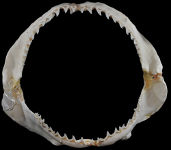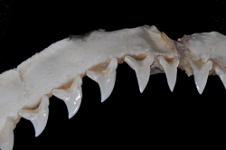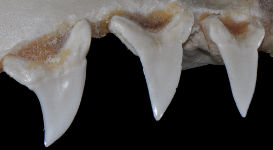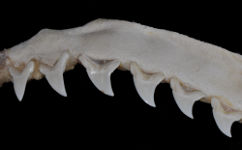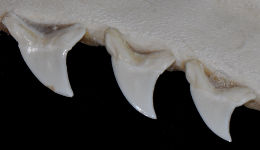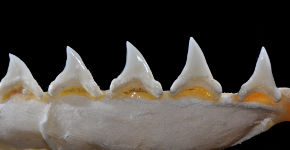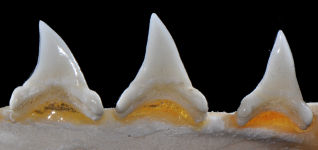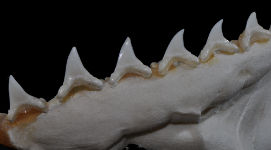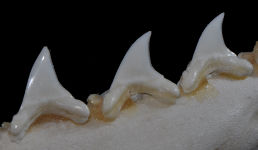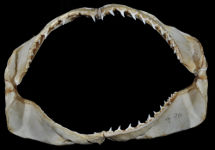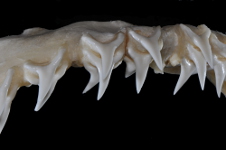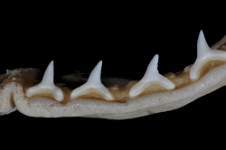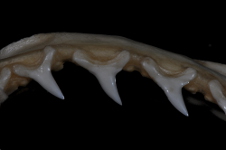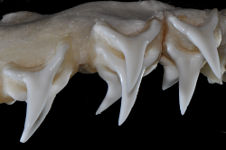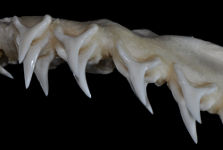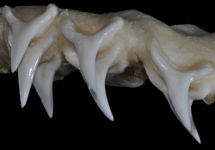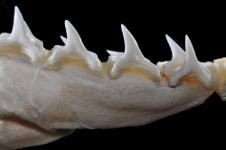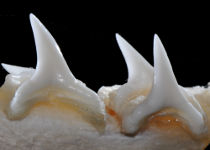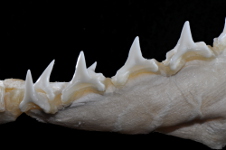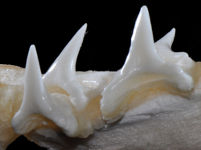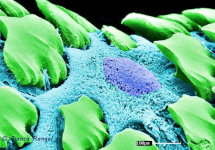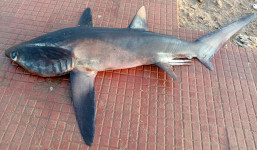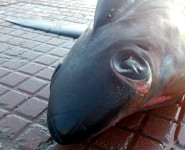Alopias superciliosus
(Lowe, 1841)
Bigeye thresher
Classification: Elasmobranchii Lamniformes Alopiidae
Reference of the original description
A paper from the Rev. R.T. Lowe, M.A., describing certain new species of Madeiran fishes, and containing additional information relating to those already described. Proceedings of the Zoological Society of London, 8, 36–39
A paper from the Rev. R.T. Lowe, M.A., describing certain new species of Madeiran fishes, and containing additional information relating to those already described. Proceedings of the Zoological Society of London, 8, 36–39
Image of the original description
No image in first description.
No image in first description.
Synonyms / new combinations and misspellings
Alopecias superciliosus, Alopias aff. superciliosus, Alopias cf. superciliosus, Alopias profundus, Alopias superciliousus
Alopecias superciliosus, Alopias aff. superciliosus, Alopias cf. superciliosus, Alopias profundus, Alopias superciliousus
Description :
Citation: Alopias superciliosus (Lowe, 1841): In: Database of modern sharks, rays and chimaeras, www.shark-references.com, World Wide Web electronic publication, Version 01/2026
Please send your images of "Alopias superciliosus" to info@shark-references.com
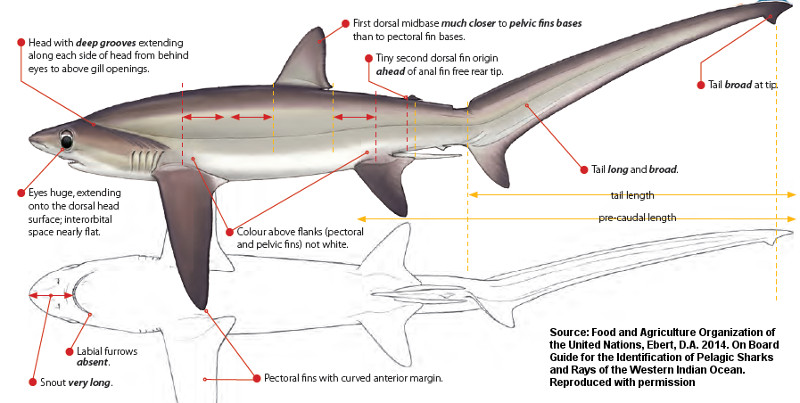
Alopias superciliosus (Lowe, 1841), © FAO, Food and Agriculture Organization of the United Nations, Ebert, D.A. 2014. On Board Guide for the Identification of Pelagic Sharks and Rays of the Western Indian Ocean. Reproduced with permission, illustration by Marc Dando , Wildlife Illustrator

Alopias superciliosus (Lowe, 1841), © FAO, Food and Agriculture Organization of the United Nations, Ebert, D.A. 2014. On Board Guide for the Identification of Pelagic Sharks and Rays of the Western Indian Ocean. Reproduced with permission, illustration by Marc Dando , Wildlife Illustrator
Common names
 Großäugiger Drescherhai,
Großäugiger Drescherhai,  Großäugiger Fuchshai,
Großäugiger Fuchshai,  Azotador,
Azotador,  Coleto,
Coleto,  Coludo cebucano,
Coludo cebucano,  Pejerrabo,
Pejerrabo,  Pez zorro,
Pez zorro,  Tiburón zorro,
Tiburón zorro,  Tiburón zorro de ojo grande,
Tiburón zorro de ojo grande,  Zorro,
Zorro,  Zorro blanco,
Zorro blanco,  Zorro de mar,
Zorro de mar,  Zorro negro,
Zorro negro,  Zorro ojon,
Zorro ojon,  Renard à gros yeux,
Renard à gros yeux,  Big eye thresher shark,
Big eye thresher shark,  Big-eye shark,
Big-eye shark,  Big-eyed thresher,
Big-eyed thresher,  Bigeye thresher,
Bigeye thresher,  Bigeye thresher shark,
Bigeye thresher shark,  Bigeye tresher,
Bigeye tresher,  Long-tailed shark,
Long-tailed shark,  Thresher shark,
Thresher shark,  Whiptail,
Whiptail,  Pesce volpe occhio grosso,
Pesce volpe occhio grosso,  Cação-raposa-olho-grande,
Cação-raposa-olho-grande,  Peixe-raposo,
Peixe-raposo,  Peixe-rato,
Peixe-rato,  Raposo-de-olhos-grandes,
Raposo-de-olhos-grandes,  Tubarão raposo,
Tubarão raposo,  Tubarão-raposa de olho grande,
Tubarão-raposa de olho grande,  Tubarão-raposo-olhudo,
Tubarão-raposo-olhudo,  Zorro olho grande,
Zorro olho grande,  Zorro-de-olhos-grandes, Pixxivolpi ghajnu kbira (malta)
Zorro-de-olhos-grandes, Pixxivolpi ghajnu kbira (malta)
 Großäugiger Drescherhai,
Großäugiger Drescherhai,  Großäugiger Fuchshai,
Großäugiger Fuchshai,  Azotador,
Azotador,  Coleto,
Coleto,  Coludo cebucano,
Coludo cebucano,  Pejerrabo,
Pejerrabo,  Pez zorro,
Pez zorro,  Tiburón zorro,
Tiburón zorro,  Tiburón zorro de ojo grande,
Tiburón zorro de ojo grande,  Zorro,
Zorro,  Zorro blanco,
Zorro blanco,  Zorro de mar,
Zorro de mar,  Zorro negro,
Zorro negro,  Zorro ojon,
Zorro ojon,  Renard à gros yeux,
Renard à gros yeux,  Big eye thresher shark,
Big eye thresher shark,  Big-eye shark,
Big-eye shark,  Big-eyed thresher,
Big-eyed thresher,  Bigeye thresher,
Bigeye thresher,  Bigeye thresher shark,
Bigeye thresher shark,  Bigeye tresher,
Bigeye tresher,  Long-tailed shark,
Long-tailed shark,  Thresher shark,
Thresher shark,  Whiptail,
Whiptail,  Pesce volpe occhio grosso,
Pesce volpe occhio grosso,  Cação-raposa-olho-grande,
Cação-raposa-olho-grande,  Peixe-raposo,
Peixe-raposo,  Peixe-rato,
Peixe-rato,  Raposo-de-olhos-grandes,
Raposo-de-olhos-grandes,  Tubarão raposo,
Tubarão raposo,  Tubarão-raposa de olho grande,
Tubarão-raposa de olho grande,  Tubarão-raposo-olhudo,
Tubarão-raposo-olhudo,  Zorro olho grande,
Zorro olho grande,  Zorro-de-olhos-grandes, Pixxivolpi ghajnu kbira (malta)
Zorro-de-olhos-grandes, Pixxivolpi ghajnu kbira (malta)
Short Description
A large thresher with very large eyes, an indented forehead, a broad caudal tip, and curved broad-tipped pectoral fins; 1st dorsal fin further back than in other threshers [536]. Upper lobe of caudal fin very long and strap-like almost or quite equal to length of rest of shark; lower lobe short but well developed [20050]. Purplish grey above, cream below, posterior edges of pectoral and pelvic fins and sometimes first dorsal fin dusky; light color of abdomen not expanded over pectoral-fin bases [20050]. Diet: pelagic waters between the U.S.-Mexico border and Cape Mendocino, California (data base: of 26 stomachs examined, 23 contained food items representing 20 taxa): Of the 10 taxa of teleosts found in the diet, fish of the family barracudinas (Paralepididae) represented the most important prey item (GII = 52.8; %IRI = 45.98), followed by Pacific hake (Merluccius productus; GII = 38.4; %IRI = 24.23), Pacific saury (Cololabis saira;GII = 22.2; %IRI = 8.08), Pacific mackerel (Scomber japonicus;GII = 17.3; %IRI = 3.92), and northern anchovy (Engraulis mordax; GII = 16.0; %IRI = 3.93).Of the eight taxa of cephalopods, jumbo squid (Dosidicus gigas; GII = 15.5; %IRI =3.61) and Gonatus spp. squid (GII = 11.0;%IRI = 0.63) were proportionately highest in ranking. [16891];
A large thresher with very large eyes, an indented forehead, a broad caudal tip, and curved broad-tipped pectoral fins; 1st dorsal fin further back than in other threshers [536]. Upper lobe of caudal fin very long and strap-like almost or quite equal to length of rest of shark; lower lobe short but well developed [20050]. Purplish grey above, cream below, posterior edges of pectoral and pelvic fins and sometimes first dorsal fin dusky; light color of abdomen not expanded over pectoral-fin bases [20050]. Diet: pelagic waters between the U.S.-Mexico border and Cape Mendocino, California (data base: of 26 stomachs examined, 23 contained food items representing 20 taxa): Of the 10 taxa of teleosts found in the diet, fish of the family barracudinas (Paralepididae) represented the most important prey item (GII = 52.8; %IRI = 45.98), followed by Pacific hake (Merluccius productus; GII = 38.4; %IRI = 24.23), Pacific saury (Cololabis saira;GII = 22.2; %IRI = 8.08), Pacific mackerel (Scomber japonicus;GII = 17.3; %IRI = 3.92), and northern anchovy (Engraulis mordax; GII = 16.0; %IRI = 3.93).Of the eight taxa of cephalopods, jumbo squid (Dosidicus gigas; GII = 15.5; %IRI =3.61) and Gonatus spp. squid (GII = 11.0;%IRI = 0.63) were proportionately highest in ranking. [16891];
Distribution
Circumtropical. Western Atlantic: New York, USA southward to Bahamas and Cuba; Panama [1388] to Uruguay [5839]. Eastern Atlantic: Portugal to Angola, including the Mediterranean. Indo-Pacific: Arabian Sea, Madagascar, South Africa, southern Japan, Taiwan, northern Viet Nam [20050], New Caledonia, northwestern coast of Australia, New Zealand and north and south of the Hawaiian Islands Eastern Pacific: southern California (USA), Costa Rica and Panama (Ref. 9253), Galapagos Islands Highly migratory species, Annex I of the 1982 Convention on the Law of the Sea [20076].
First records: 2019: New Ireland Province, Papua New Guinea, western Pacific Ocean [27359] Source: www.gbif.org
Circumtropical. Western Atlantic: New York, USA southward to Bahamas and Cuba; Panama [1388] to Uruguay [5839]. Eastern Atlantic: Portugal to Angola, including the Mediterranean. Indo-Pacific: Arabian Sea, Madagascar, South Africa, southern Japan, Taiwan, northern Viet Nam [20050], New Caledonia, northwestern coast of Australia, New Zealand and north and south of the Hawaiian Islands Eastern Pacific: southern California (USA), Costa Rica and Panama (Ref. 9253), Galapagos Islands Highly migratory species, Annex I of the 1982 Convention on the Law of the Sea [20076].
First records: 2019: New Ireland Province, Papua New Guinea, western Pacific Ocean [27359] Source: www.gbif.org
Human uses
fisheries: commercial; gamefish: yes
fisheries: commercial; gamefish: yes
Biology
Exhibit ovoviparity (aplacental viviparity), with embryos feeding on other ova produced by the mother (oophagy) after the yolk sac is absorbed [733]. With 2-4 young per litter (usually 2) [518]. Size at birth between 64-106 cm [518]; 100-140 cm TL [2539]. No fixed mating or birthing season. Distinct pairing with embrace [17086]. Occurs on the continental shelf and slope (Ref. 75154).
Exhibit ovoviparity (aplacental viviparity), with embryos feeding on other ova produced by the mother (oophagy) after the yolk sac is absorbed [733]. With 2-4 young per litter (usually 2) [518]. Size at birth between 64-106 cm [518]; 100-140 cm TL [2539]. No fixed mating or birthing season. Distinct pairing with embrace [17086]. Occurs on the continental shelf and slope (Ref. 75154).
Size / Weight / Age
488 cm TL (male/unsexed; (Ref. 40637)); max. published weight: 363.8 kg (Ref. 40637); max. reported age: 20 years[5660]
488 cm TL (male/unsexed; (Ref. 40637)); max. published weight: 363.8 kg (Ref. 40637); max. reported age: 20 years[5660]
Habitat
pelagic-oceanic; oceanodromous [17660]; marine; depth range 0 - 500 m (Ref. 9253), usually 0 - 100 m [531]
pelagic-oceanic; oceanodromous [17660]; marine; depth range 0 - 500 m (Ref. 9253), usually 0 - 100 m [531]
Remarks
shark-references Species-ID=194; CITES: (see: Protected Species for more details) Convention on International Trade in Endangered Speciesof Wild Fauna and Flora annex: II; Council Regulation 2017/160 annex: B
shark-references Species-ID=194; CITES: (see: Protected Species for more details) Convention on International Trade in Endangered Speciesof Wild Fauna and Flora annex: II; Council Regulation 2017/160 annex: B
Parasites (arranged by Jürgen Pollerspöck)
Cestoda
Nematoda
Copepoda
Cestoda
- Hepatoxylon trichiuri (Holten, 1802) [16112]
- Litobothrium alopias Dailey, 1969 [16293]
- Litobothrium amplifica (Kurochkin & Slankis, 1973) [7374] [23771]
- Litobothrium amplificum (Kurochkin & Slankis, 1973) Euzet, 1994 [16217]
- Litobothrium coniforme Dailey, 1971 [16293]
- Litobothrium daileyi Kurochkin & Slankis, 1973 [16217] [7374] [23771]
- Litobothrium janovyi Olson & Caira, 2001 [7374] [16908] [23771]
- Litobothrium sp. [26119]
- Mixonybelinia lepturi Palm, 2004 [16112]
- Molicola walteri Palm, 2004 [16112]
- Nybelinia africana Dollfus, 1960 [16112]
- Nybelinia indica Chandra, 1986 [16112]
- Sphyriocephalus dollfusi Bussieras & Aldrin, 1968 [16112]
- Sphyriocephalus pelorosoma Heinz & Dailey, 1974 [16323] [16112]
- Sphyriocephalus sp. [16112]
- Sphyriocephalus viridis (Wagener, 1854) Pintner, 1913 [16112] [25091]
Nematoda
- Anisakis sp. [26119]
Copepoda
- Bariaka alopiae Cressey, 1966 [16542] [16583] [17259] [15303] [28059] [28156]
- Dinemoura discrepans Cressey, 1967 [16599] [17259] [15303] [14993] [19356] [19355]
- Dinemoura sp. [16583]
- Echthrogaleus asiaticus Ho, Liu & Lin, 2012 [21826]
- Echthrogaleus denticulatus Smith, 1873 [17259] [19356] [19355]
- Nogagus borealis (Steenstrup & Lütken, 1861) [17259]
- Pagina tunica Cressey, 1963 [12170] [16583] [16599] [17259] [15303] [16578] [22562] [17377]
- Pandarus satyrus Dana, 1849 [17259]








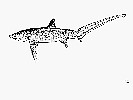
.jpg)
.jpg)
.jpg)
.jpg)
.jpg)

